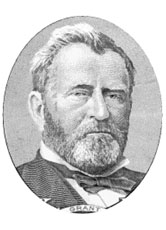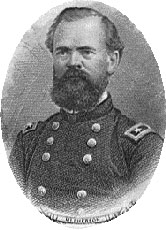One of the most striking characteristics of the Corps of Engineers during the Civil War was its ability to provide officers who could serve in almost any capacity--from building roads to directing staffs to commanding troops. Certainly one of the best examples of this facility was Major General James Birdseye McPherson. An 1853 graduate of West Point, McPherson worked on the defenses of New York Harbor and was Superintending Engineer of the construction of the Alcatraz Island fortifications when the Civil War broke out. He promptly returned to the East, where he aided in recruiting the U.S. Engineer Battalion.
 |
Brig. Gen. Ulysses S.
Grant |
 |
| Maj. Gen. James B. McPherson |
In late 1861 he was transferred to the Department of Missouri. There he attracted the attention of then Brigadier General Ulysses S. Grant, on whose staff he served as chief engineer, Army of the Tennessee, at the capture of Forts Henry and Donelson and at the Battle of Shiloh (6-7 April 1862). For 5 months he was the Superintendent of Military Railroads for the District of West Tennessee, and managed despite a shortage of equipment and constant guerrilla harassment, to keep the railroads open for Grant's forces.
From October 1862 onward he was constantly in the field, commanding first a brigade, then a division, and finally an army corps in the operations against Vicksburg. During the siege of the fortress, he frequently acted as his own engineer. His most arduous field service was in Major General William T. Sherman's Atlanta campaign, when he led the Army of the Tennessee. Now a brigadier general in the Regular Army, as well as a major general of volunteers, he frequently commanded Sherman's flanking column, participating in the actions of Resaca, Dallas, Kennesaw Mountain, the crossing of the Chattahoochee, and the battles before Atlanta.
Tragically, on 22 July 1864, he was killed in action. While hurrying to correct a faulty deployment of his troops, he encountered a party of Confederate skirmishers. Upon ignoring their order to halt, he was shot out of his saddle. McPherson, who had been chosen by Sherman as his successor, and whom Grant expected to eventually become general-in-chief, was just 36 years old. Grant had named him and Sherman as "men of whom . . . I feel indebted for whatever I have had of success," while Sherman called him "that bright particular star."
On 18 October 1876, members of the Society of the Army of the Tennessee unveiled an equestrian statue, with captured cannon, of McPherson surveying a battlefield. Today this site, known as McPherson Square, also is a popular Washington, D.C. Metro transit commuter-rail stop.
* * *
May 2001